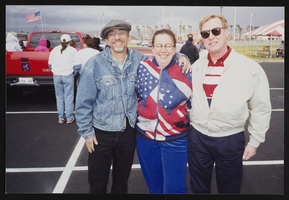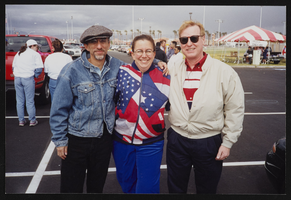Search the Special Collections and Archives Portal
Search Results
Patricia Bryan oral history interview
Identifier
Abstract
Oral history interview with Patricia Bryan conducted by Stephen Kulifay on February 20, 1979 for the Ralph Roske Oral History Project on Early Las Vegas. In this interview Patricia Bryan discusses her education at University of California, Los Angeles (UCLA) and Northwestern and her move to Las Vegas, Nevada in 1947. Bryan also discusses her family’s involvement in the soda bottling industry and eventual involvement in real estate. She goes on to describe a wide range of topics including the first hotel properties in the city, the entertainers at the time, minority communities, the railroad, shopping, and housing. She also discusses the popularity of Las Vegas, with a focus on tourists and gaming. Digital audio and transcript available.
Archival Collection
Kent Carmichael oral history interview
Identifier
Abstract
Oral history interview with Kent Carmichael conducted by Stefani Evans on November 25 and December 2, 2019 for the Boyer Early Las Vegas Oral History Project.
In the first session of this oral history, Carmichael discusses his early career in lighting design and maintenance from his start at Interstate Neon to his work in the 1950s and 60s in Las Vegas. He discusses some of the iconic signs he built including the Casino Center, Carnival Room, Thunderbird, The Frontier, Bonanza, and the Stardust. He also details the technology and inner workings of these innovative signs including the transition from mechanical to electrically controlled signage. Carmichael continues to discuss Native American laborers and various individuals that he interacted with throughout his early career including Max and Mo Oggenblick, Doby Doc, Benny Binion, Arby Alper, Steve Wynn, Peter Arp, and Wayne and Jerry Newton. Carmichael ends the first interview by recalling a high wind event that damaged the Frontier sign and his efforts to bring the sign under control and repair it as well as his vision and behind the Stardust sign.
The second oral history interview contains Carmichael’s discussion of his career from 1968 onward. He immediately picks up discussion of the Stardust sign and his transition to desk work. Carmichael details the challenge and limitations of designing the International sign (the Westgate as of 2021). He describes the development of his first messenger sign for the International and the time consuming task of using tape to program the sign. He fondly remembers working on the Holiday Inn Riverboat signs, and International transition to Las Vegas Hilton and the Hilton’s transition from blue to red letters. Carmichael shares the story of being caught between organized crime and a young Steve Wynn. He recounts his last project for Ad Art, developing and construction the sign for the Louisiana Superdome in New Orleans, Louisiana. He details working through legislative and construction issues as well as the fallout from the Nat Kiefer Commission.
After leaving Ad Art Carmichael began working with Heath and Co. and began collaborating with Raul Rodriguez. Carmichael and Rodriguez went on to design some of the most enduring and visually unique signs in Las Vegas including, the Flamingo, Four Queens, Golden Nugget, Dunes Hotel, and the Desert Inn. They also worked in Reno on Circus Circus and El Dorado. Carmichael also details his interior work including the main pylon and interior signs for MGM Grand; 1974 renovation Golden Nugget, suspended stained glass ceiling at Tropicana, and the MGM Lion display. Lastly Carmichael outlined his work with Young Electric Sign 1983-85 and the Dewey Sign Company including the Las Vegas Convention Center sign. He ends by sharing his views on the role and importance of lighting in Las Vegas.
Archival Collection
Marie McMillan oral history interview
Identifier
Abstract
Oral history interview with Marie McMillan conducted by Kelli Luchs on September 15, 2009, September 23, 2009 October 01, 2009, and November 24, 2009 for the Boyer Early Las Vegas Oral History Project. In this interview, Marie McMillan discusses life during the Great Depression and World War II. She then talks about marrying Duke Daly, raising a family with him, Daly passing away, moving to Las Vegas, Nevada in 1961, and working at the Nevada Test Site. She then discusses being a single mother, marrying James McMillan, and her great passion for aviation. She also talks about her role as a leader in the African American community and her flying records.
Archival Collection

Peck, Brown, and Parks at the second annual Gay Pride parade, image 001: photographic print
Date
Archival Collection
Description
Gay Pride 1998 (Dennis McBride, photographer) 4-25-98. 2nd annual parade. (L-R: Gary Peck, American Civil Liberties Union; Lori Lipman Brown; Nevada State Assemblyman David Parks.)
Image

Peck, Brown, and Parks at the second annual Gay Pride parade, image 002: photographic print
Date
Archival Collection
Description
Gay Pride 1998 (Dennis McBride, photographer) 4-25-98. 2nd annual parade. (L-R: Gary Peck, American Civil Liberties Union; Lori Lipman Brown; Nevada State Assemblyman David Parks.)
Image
Daryl Morris oral history interview
Identifier
Abstract
Oral history interview with Daryl Morris conducted by Barbara Tabach on February 16, 2016 for the Southern Nevada Jewish Heritage Project. Morris discusses being raised in Las Vegas, Nevada as the son of musicians Bobby Morris and Paula Morris. He also discusses his career as an actor and insurance agent, as well as his activity in the Las Vegas Jewish community.
Archival Collection
Jerome Countess oral history interview
Identifier
Abstract
Oral history interview with Jerome Countess conducted by Dorothy Eisenberg on October 28, 2014 for the Southern Nevada Jewish Heritage Project. Countess discusses coming to Las Vegas, Nevada in 1976 to take a job with what became the Jewish Federation. He then talks about starting the local Jewish Reporter, a newspaper, and creating a community among fellow Jews in Las Vegas.
Archival Collection
Cherina Kleven oral history interview
Identifier
Abstract
Oral history interview with Cherina Kleven conducted by Cecilia Winchell on June 9, 2021 for Reflections: The Las Vegas Asian American and Pacific Islander Oral History Project. Cherina Kleven talks about her family and childhood growing up in Taiwan amongst six siblings. She shares her family's history and how they immigrated to Las Vegas while she was a teen, as well as her employment history and how she met her husband. Cherina talks about racial and gender discrimination and the obstacles she has overcome to be the only working female in her family, the only woman firefighter at her station house, and the first female Asian American Assistant Fire Chief in the United States.
Archival Collection
Alan Stock oral history interview
Identifier
Abstract
Oral history interview with Alan Stock conducted by Barbara Tabach on December 27, 2017 for the Remembering 1 October Oral History Project. In this interview, Alan Stock discusses moving to Las Vegas, Nevada in 1999 for his job as a radio talk show host for KXNT. Stock describes the broadcast that covered the October 1, 2017 Las Vegas mass shooting from 11 PM on that night until 9 AM the next morning. He talks about some of the calls the station received from various members of the community, including survivors of the shooting, families of those at the event, people on lockdown in the nearby hotels, doctors, and general listeners. Stock describes some of the topics discussed on the broadcast, such as what was currently happening on the Las Vegas Strip, stories of the aftermath, and the support needed from the general public. Other topics include gun control and conspiracy theories. He discusses the impact this and other shootings would have on public affairs, including tighter security in daily living and public gatherings. He compares security in the United States to security in Israel and other countries, focusing on the idea of unconcealed guns worn in public. Throughout this interview, Alan Stock explains that the radio station's goal was to provide accurate information to the public during the aftermath of the October 1, 2017 mass shooting.
Archival Collection
Carol [Pattinose] oral history interview
Identifier
Abstract
Oral history interview with Carol Pattinose conducted by Gayle Allen for the KDWN Radio Lifelines Oral History Interviews on Nursing.
This interview is undated but likely took place between 1988 and 1999, the time span that "Lifelines with Gayle Allen" was taped by KDWN Radio.
Carol Pattinose, a registered nurse at Nathan Adelson Hospice, defines terminal illness and discusses the reasons a patient might be admitted into a hospice. She talks about quality of care associated with end of life and how hospice care is more of a philosophy of care rather than a place someone is admitted, where the main goal is to keep patients comfortable in their own homes and assist with pain control.
Archival Collection
